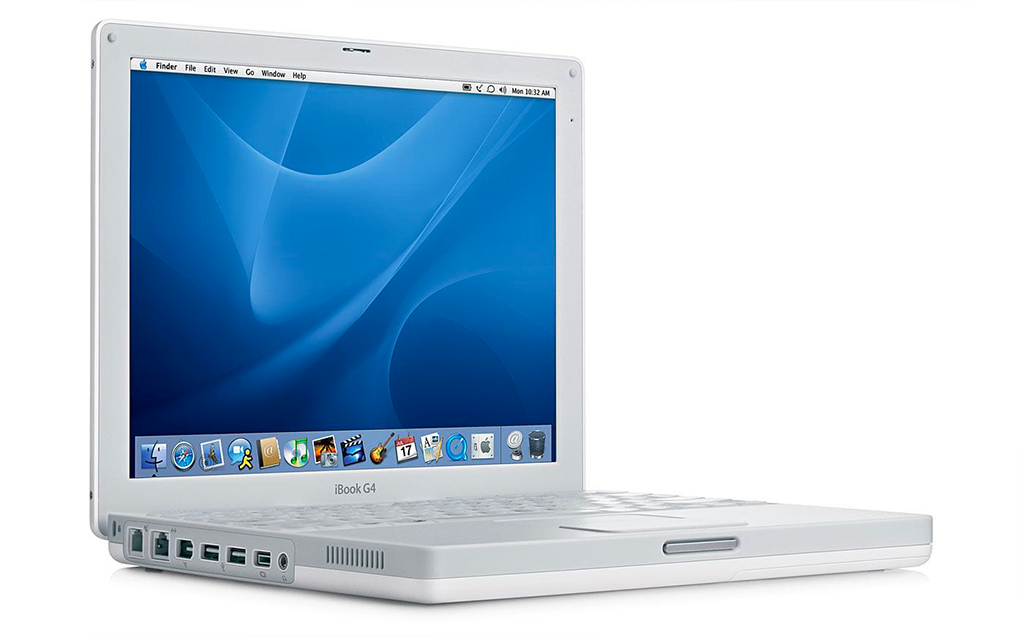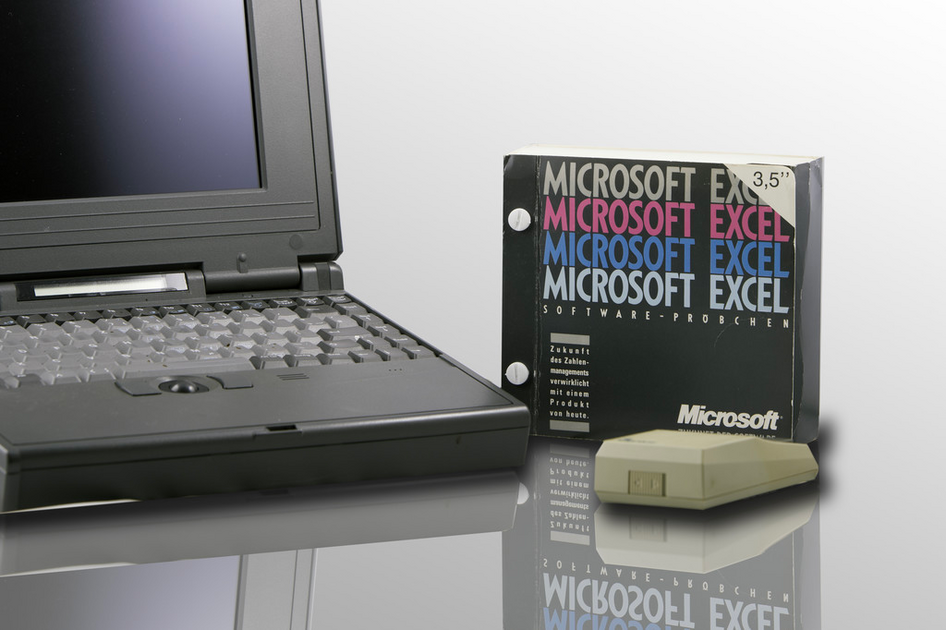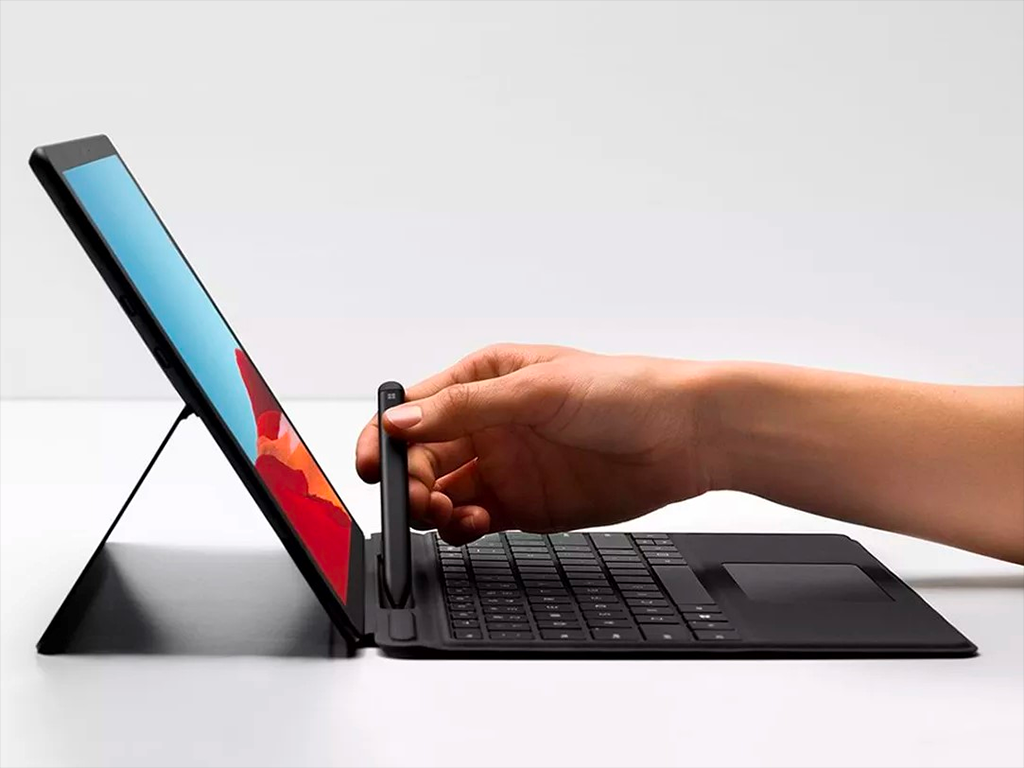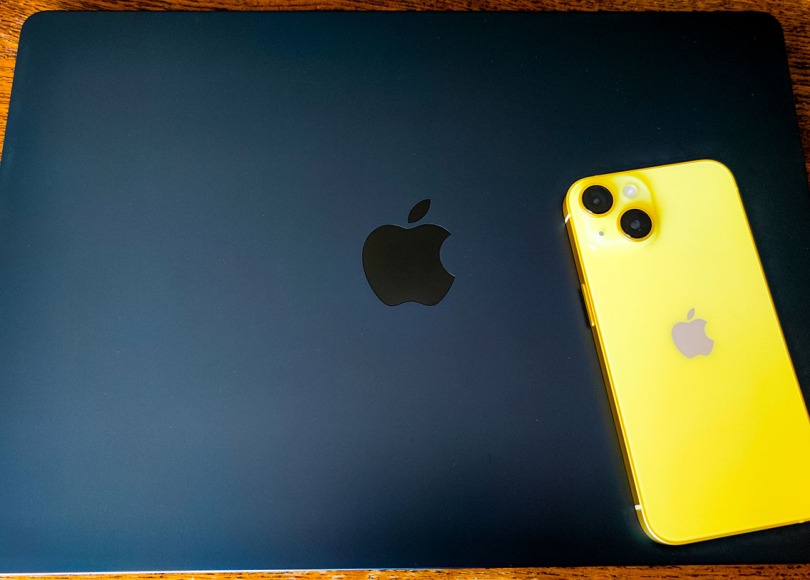A long, contrasted relationship
When it comes to a significant change in an everyday technological environment, as in this example where I’m describing the switch from Windows 11 on a Surface Laptop 3 to Mac OS Sonoma on a 15-inch Macbook Air M2, it is important to provide a bit of context.
Apple and I had an intense love affair a long time ago, when the cult brand wasn’t as mainstream as it is today. In fact, I was a staunch supporter and advocate of the Californian company when everyone thought it was about to die. And for good reason: the user experience of its products was miles ahead of the competition, with advanced features that made computing much more enjoyable, productive, and fluid. At the time, my Apple computers were my most prized possessions, even before my collection of gaming consoles or PSG jerseys.

A distinctive rationale behind my support for Apple was that the Cupertino-based company was making bold choices, in particular using different processors from the competition, in the form of IBM PowerPC chips and their RISC architecture. I liked the feeling of being part of a community that wanted to move computing forward, rather than just being a passive consumer.
My passion for Apple lasted for years and led me into some rather iconoclastic situations for the time. For example, when I was student at EDHEC Business School, a renowned academic institution in which I was probably one of the poorest students (I worked on the side in fast-food restaurants to pay for my studies and apartment), I was the only one using a Mac, even among those who had chosen the marketing specialization. It was a topic of discussion, with a lot of people asking me why I was using this computer that seemed useless to them.
This culminated a few months before graduation when I applied to Microsoft and… got hired, even starting work while I was still a student!
I made no secret of my preference for Mac OS to the hiring managers, and even tried to explain why I thought it was superior. Much to their surprise. But to be fair, I loved Microsoft products, and it was my dream destination, as I felt it had much more potential (Xbox!) and was at the top of the world. I continued to use Macs for some time at Microsoft, advocating their use internally, which in retrospect is rather amusing given the period involved and the nature of my first job (I was working in the evangelism team).

But I ran into problems with my first Intel-based Macs. And from then on, everything went downhill.
Two Macs had critical and unexpected issues after just over a year. For the first, I put it down to bad luck. After trying to recover it in a number of ways to no avail, I simply bought another Mac without complaining, almost taking the blame for this bad experience on myself.
When my second “Intel Mac” ran into similar problems, I couldn’t look away. Especially as the color of the keyboard had changed markedly, something I’d never experienced before or since. It was more than just a coincidence, manufacturing quality had declined, and Apple’s uniqueness (like its processors) no longer existed, at least in my opinion.
Since I was working at Microsoft and had direct access to promising product roadmaps and immensely talented people who were passionate about the company’s direction, I thought it was time for me to move on.
Think different, no more
Although I was still buying Apple products from time to time, my relationship with the company gradually waned, especially after Steve Jobs’ death.
As the popularity of Macs soared, I thought it was largely the result of impeccable corporate marketing, the halo effect of the iPhone, and herd-like behavior of consumers who wanted to buy a status and didn’t really care about product features and experience. In short, I thought their growing popularity was unjustified and even unfair, as the company wasn’t sufficiently appreciated when it was a leading innovator in the computer’s world.
For many years, there wasn’t even a match for me: Macs as objects had nice physical designs, but they were deficient in almost every other respect, and the genuine innovation for which I originally loved them was replaced by infamous acts of “courage”.
What about virtual reality on the Mac? Touch and pen input? New form factors? Facial recognition? Cloud streaming capabilities? Cellular connectivity? Mixed reality?

I vividly remember a conversation with a colleague at Ubisoft, an unconditional Apple fan whom I liked a lot because I’ve always been interested in hearing different points of view. I said to him at the time: “you’ll see, even Apple will eventually adopt ARM processors, but Microsoft will be so far ahead that it will be difficult for Apple to catch up”.
This was about the Microsoft Surface RT, equipped with an ARM processor designed by Nvidia, which I immediately pre-ordered for its release in 2012. Obviously, I was half right and half wrong, but I can tell you that my interlocutor saw the future even less clearly than I did 😉
The “Think Different” golden age that I cherished is long gone. Apple devices are now everywhere, especially in certain socio-economic circles where the use of non-Apple hardware is the exception. Looking at photos of universities around the world, the change was easy to notice. In just a few years, Macs that nobody bought at a time when they were undoubtedly far better than the competition, are now the only computer students purchase. What a joyful diversity…

For all these reasons, and because I’m a big fan of Microsoft’s continuous improvements, innovation, risk-taking, bets on the future (cloud computing, AI) and much more “open” stance, I never went back on my decision, even though I took the time to try out new Macs every couple of years.
Apple caught my eye with Apple Silicon and hooked me with Vision Pro
After disappointing years that had me thinking that the Apple of the past was indeed no more (eg. the butterfly keyboard), and that I was far better off using high-end Windows laptops and building my own powerful gaming desktops, things began to unexpectedly turn around in 2020.
That’s when Apple unveiled the Apple M1, its first proprietary system-on-a-chip based on ARM architecture, designed as a CPU and GPU for the Macintosh. The M1 was billed as “the world’s fastest CPU core in low power silicon” and as having “the world’s best CPU performance per watt”. BOOOOOM. 🤯

That’s what my reaction might have been. But I’ve become suspicious of Apple’s “reality-distortion field” and its ability to cherry-pick data to tell a story that isn’t quite representative of the truth.
So, I was very intrigued, but slightly skeptical. And indeed, the first real-life benchmarks painted a more nuanced story than the one presented by Apple. Yet, performance was still remarkable compared to Intel and AMD’s offerings for laptops. It was audacious. It felt like a new Apple.
On the other side of the bench, Microsoft’s ARM initiative was slow to take off, despite a first full version of Windows on ARM dating back to 2015. Processors lagged behind their x86 counterparts, there were driver compatibility issues, and emulation was incomplete at first and slow. In the Windows world, there is clearly a compromise to make between performance + compatibility or power consumption, a trade-off in favor of x86 for most users.

Because Windows 10 and 11 brought so much quality-of-life and were perfectly integrated in my workflow, I thought it was worth waiting for Nuvia’s processors, a company acquired by Qualcomm and made up of people who had worked on Apple Silicon. A few years to wait is good enough.
But the Nuvia processors, named Oryon, have been a long time coming, more than expected. They are promising, and the first benchmarks published are impressive. They have the potential to not only match but beat Apple Silicon, at least in a few years. The problem is that they are not here yet.
And then there was the announcement of the Apple Vision Pro which, despite all its immediately visible flaws and even the absence of use cases at this stage, finally convinced me that something was brewing in Cupertino. Innovation and bold bets have returned, but they’re now backed by the world’s richest and most powerful company. This got me excited.
Time for a change
While I was still waiting for news on Oryon, it didn’t take more than three weeks after the reveal of Vision Pro for me to say to myself: “f*, let’s do it!”.
The desire for a refreshing computing experience was evident, especially as major personal changes were taking place in my life.
And even though I had my doubts, opportunities presented themselves: my professional and personal situation meant I was often on the move, and I was looking for a light but powerful device with long battery life. What’s more, I’d had enough of using Android devices that I’ve never liked (my heart still lies with Windows Phone), and finally my birthday was coming up… All good reasons.
So, I embarked on an exhaustive, albeit gradual, transition to the full Apple stack: computers, phones, accessories, services. I was well aware that part of the magic of such a proprietary ecosystem lies in its level of integration, so I preferred to go all-in to see what it was worth today.
Comparing Apples to Apples
The objective of this post so far has been to show how corporate strategies and consumer experience can influence perception. Now it’s time to give you some basic keys to understanding that you can use to self-assess the opportunity for a switch in a direction or another.
There will be no in-depth comparative analysis or technical benchmarks, as many sites have already done those better than I could. Instead, I’ll help you clarify your needs, as these two excellent operating systems are virtually on an equal footing.
Let’s put two aspects aside right away: price and security.
Today, the price of certain ranges of Macs, such as the Macbook Air, is quite competitive, and even if there are disadvantages like less storage space or RAM for similar prices in the Windows world, there are also advantages like the Apple Silicon or resale price. In short, if your budget allows you to look for more than low-end Windows PCs or Chromebooks, price is no longer a relevant criterion.
When it comes to security, there’s always been a myth around Apple, even back in the day: “there are no viruses”. That’s a load of rubbish. Both Apple and Microsoft take security very seriously and have an army of engineers constantly working to improve it. There were indeed fewer viruses on Macs, but that was due to their abysmal market share. Now that the situation has changed, there are and will be more and more viruses on Macs. The best security is you.

Finally, it’s important to point out two things before moving on to the Mac vs. Windows comparison:
- Contrary to the opinions you read after only a few days of use, I’ve taken the time to properly evaluate my experience: the Macbook Air 15-inch M2 has been my daily driver for 6 months now.
- I’ve tried to keep my workflow as close as possible to what it was before, which hasn’t been a huge problem since all the applications and services I used on Windows are also available on the Mac, including the whole Microsoft suite, from Office 365 to Microsoft Edge.
User Experience: a TIE
Before switching back to the Mac, this was certainly an area where I thought Apple would reign supreme. I regularly complained about the lack of consistency in the Windows UI, whose legacy is a handicap that the Redmond-based company is struggling to correct.
But to my surprise, it’s a tie, and I’d say that for more demanding activities, Windows wins slightly. Here’s how it breaks down:
| Mac OS Sonoma is better | Windows 11 is better |
| – UI consistency – Cross-device experience (Apple ecosystem only) – Full-screen mode – Spotlight search – Better keyboard (É, À,Ù…) – Better inbox apps, no crapware – Hardware UX – General build quality (compared to an average PC manufacturer) – Fewer system “ads”, better privacy | – Apps & Hardware compatibility – Windowing / Snapping – App context (easier to go back to what you were doing, whereas app windows can be “hidden” in Mac OS) – Multi-screen management – Jump Lists – Cross-platform integration (Edge, OneDrive, Android, Linux, iCloud photos in the Photos app…) – Windows Hello – Apps install and OS updates (more consistency, much faster) – File Explorer (thanks to recent improvements) |
The user experience is vastly different but there are strong pros and cons for each OS, so it’s important to assess your current context and needs.
Generally, I’d say that the user experience is more delightful on Mac OS but more efficient on Windows. For example, if you’re working with multiple windows at the same time, you’ll quickly go crazy with Mac OS: jump lists, snapping features, app context (compared to Mac OS document context), or better multi-screen management are all elements that make life easier on Windows.
Another important aspect is the cross-device experience: if your phone is an iPhone, using a Mac makes so much more sense, despite Microsoft’s best efforts to integrate with the Apple ecosystem. On the other hand, if you have a very diverse set of devices, Windows is the best way to make them work better together.
Performance: Mac OS wins
The predominant form factor today is the laptop, or rather the ultrabook. It’s what most of us use as our main computer, and for this form factor, there isn’t even a match.
Thanks to Apple Silicon (M1, M2, M3), Macbooks far outstrip Windows ultrabooks in terms of raw performance. They’re incredibly fast. For real.
What’s more, Macbooks boast a very, very, very long battery life that Windows ultrabooks – even those based on ARM architecture – are not even close to match. And this performance and autonomy go hand in hand with an absence of noise (fanless architecture on the Macbook Air).

A final advantage for Macs: the tight integration between hardware and software means more optimized, snappier overall OS performance. One of the reasons why animations feel so much better on iOS than on Android also applies to Mac OS.
This doesn’t mean, however, that Apple has the performance advantage in all situations. One of Windows’ main strengths lies in the way it integrates with many hardware manufacturers: while Apple Silicon Macs can’t use discrete GPUs, there are no such limitations in the Windows world. And nothing comes close to the power and potential of Nvidia’s discrete GPUs for many use cases, including gaming. A Windows PC can be fully customized, component by component.
In my case, the lack of a discrete GPU is no longer an issue as I’ve gradually moved to cloud gaming since the release of Stadia (RIP), currently using GeForce NOW, Xbox Cloud Gaming and Amazon Luna, all of which work perfectly on the Mac. But for competitive gamers or those with a poor Internet connection, it’s best to use Windows for gaming. In addition, many games can’t be played in the cloud, and by far the largest library of games can be found on Windows PC.
One last important note for this category: Oryon processors, when they become available, will radically change the situation. But we’ll have to wait and see.
Innovation: Windows wins
For someone like me who is thrilled about discovering and trying out new things all the time, it seems rather clear that the Mac OS of today is quite disappointing, almost boring. It does things well, but it is very conservative in its approach.
Windows has the upper hand:
- Input (touch, pen, dictation)
- Virtual Reality
- Mixed Reality
- LLM/ AI (Copilot, GPT4 powered inbox apps such as Paint)
- Form factors (2-in1, foldables, laptops with 3 screens, handheld gaming devices…)
- Cloud-powered experiences (Windows 365, Xbox Cloud Gaming, Clipchamp)
- Web technologies integration (PWAs are in the Microsoft Store since several years)
- Cellular connectivity
- Rapid adoption of new technology standards
- Heck, even ARM was supported long before Mac OS 😉
- And much, much more!
That said, there’s no denying that, for many reasons, a lot of innovative apps or services come to the Mac first, despite its smaller market share (e.g. this app).
Apple has also made excellent use of AI, for example the ability to automatically “crop” an object or person from a photo to paste it elsewhere, and the company regularly innovates to make its ecosystem more integrated, from copy/paste that works across Apple devices to its continuity features that allow to seamlessly use an iPad as a second screen or an iPhone as a webcam.
I hope that, with Apple’s renewed interest in bold innovations, the days when Cupertino scoffed at the idea of adding a keyboard to a tablet (Surface) before introducing its own keyboard several years later for the iPad and presenting it as an innovation, are now long gone. That said, it will take years for Mac OS to become as innovative as Windows overall, if it ever catches up.
The power of choice
With its Silicon, Apple has quietly reshuffled the cards in personal computing, after a long period when its greatest strength were its brand image and seamless integration with the iPhone. Macs are becoming exciting again, even if they are not the best for all types of use and tend to lag behind in terms of innovation.
There’s no black and white answer as to which OS is better, and I wholeheartedly disagree with oversimplified advice such as “if you like gaming use Windows, otherwise Mac OS is the better choice”. It’s essential to keep an open mind, try things by yourself if you can, and make your own shopping list based on the actual pros and cons of each operating system.
Considering my current workflow and needs, I’d say I prefer Windows in general, but the better hardware of Macbooks largely makes up for Mac OS’s shortcomings from a software point of view. With one caveat that has a huge impact: in making this switch, I’ve also transitioned to the iPhone, and, after being a Windows Phone orphan, I’m finally finding some joy using a smartphone. For my personal use, the iPhone is far better than any Android device I’ve ever owned, and this fact will probably keep me in the Apple ecosystem for some time, as it’s the little plus that tip the scale in its favor. I can’t wait for Oryon processors and Windows next though.
All in all, increased competition benefits everyone, and I’m glad we have the choice between Mac and Windows.
Thanks for reading,
Antoine


I do not comment often on blogs but man your research is excellent. I think it’s the best, most nuanced post I saw on this topic.
LikeLike
It’s funny I believed I was the only one feeling same about “think different“. I share your sentiment on the 3 aspect and agree both systems are very good in their own ways. I recently switched to Win 11 coz I needed better ways to manage many windows at same time.
LikeLike